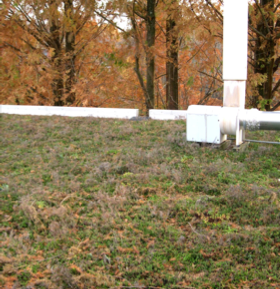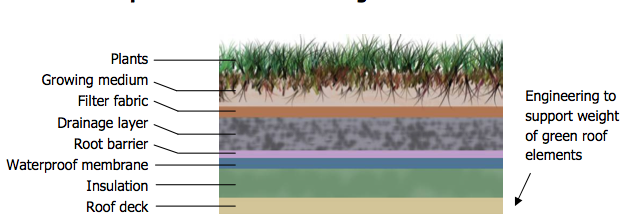
Fact Sheets And Publications

Green Roofs
Reviewed March 2025 | Written by: Rebecca Pineo, Botanic Gardens Intern and Susan Barton, Extension Specialist
What is a green roof?
A green roof is a specially-engineered rooftop that supports plant life. Green roofs have been utilized in Europe for 30 years and are quickly gaining popularity in the United States.
There are two types of green roofs:
Extensive:
This layer of low-growing, herbaceous plants, usually with limited public access. Extensive-type green roofs are designed to be low-maintenance once established.

Autumn colors of an extensive green roof at the Sanford School, Hockessin, DE.
Intensive:
Lush herbaceous and/or woody plantings growing in a thick soil layer, often incorporating spaces for public use and enjoyment. Generally, these types of roofs require major engineering efforts to support their weight and necessitate higher post-installation maintenance.

Bird's-eye view of an intensive green roof at the Ministries of Education building, Rio de Janiero, Brazil.
Common components of an extensive green roof

Plants: Densely spaced and able to live in meager soil and survive exposure to heat, cold and wind
Growing medium: 2-6” layer of lightweight, inert medium with maximum of 5-6% organic matter. Common materials include perlite, expanded shale, pumice, or crushed terracotta that won’t shrink in size over time.
Filter fabric: Separates growing medium from drainage layer
Drainage layer: Moves excess water away from plant roots
Root barrier: Prevents plant roots from penetrating the waterproof membrane
Waterproof membrane, insulation and roof deck: Same as in a traditional rooftop
Engineering to support weight of green roof elements. Extensive green roofs generally weigh between 12-50 pounds per foot, versus 10-12 pounds/foot for a conventional roof and 80-150 pounds/foot for an intensive green roof (not including snow). The sides of the roof may also need to be built up to accommodate the additional layers.
What are the benefits of green roofs?
Green roofs provide many environmental and social benefits, especially in urban areas where impermeable surfaces and unsightly rooftops dominate.
- Captures and manages stormwater. Green roofs can capture a high percentage of rainwater from storm events. This prevents the water from running off the roof, where it picks up pollutants before draining into storm pipes and eventually into our natural water bodies. By capturing stormwater onsite, green roofs also reduce the tax dollars needed to fund storm drain management systems.
- Reduces the “heat island effect.” Conventional rooftops and other impermeable surfaces absorb tremendous amounts of heat, raising ambient air temperatures in urban areas. On green roofs, plants cool air through natural processes and shield buildings from high heat levels produced by direct sunlight. According to the Environmental Protection Agency (EPA), the surface of a green roof on a hot summer day can be as much as 90° F cooler than the surface of a traditional rooftop.
- Prevents and reduces air pollution. By decreasing the heat island effect, green roofs reduce the smog and ozone that forms as air pollution mixes with high temperatures. Plants also sequester carbon dioxide and filter other air pollution particulates.
- Extends the life of rooftops. Shielded from the effects of ultraviolet light and high heat by the plant layer, green roofs last significantly longer than conventional roofs. Thus despite initially higher installation costs, the life cycle costs of a green roof can be considerably lower.
- Provides heating and cooling effects for the building. The air trapped in the various layers of the green roof act as insulation that keeps buildings warmer in winter and cooler in summer. According to Massachusetts Low Impact Development Center, a green roof can reduce winter heat loss by 25% or more. Plants also shade the rooftop from the heat of summer sunlight.
- Presents an attractive, beneficial alternative to traditional rooftop. Whether viewed from the ground or enjoyed as a public-accessible mini-park, green roofs offer an aesthetically-pleasing landscape that offers humans a myriad of mental, physical, and social benefits.
- Attracts wildlife. Insect pollinators are attracted to many extensive green roof plants, which in turn provide sustenance for birds, bats, and other insectivores. Intensive green roofs can offer habitat and food for a larger range of wildlife.
- Reduces noise pollution. Plants and growing media provide an insulating effect both inside and outside the building.
Green Roof FAQs
Can a green roof be retrofitted on an existing structure?
New construction can easily be designed to support the high weight loads of a green roof. Retrofitting a green roof offers more of a challenge, but can usually be accommodated with thoughtful engineering. When new or old, the waterproof membrane needs to be in excellent working condition to ensure the success of a green roof.
How much does a green roof cost?
At the time of writing, the EPA estimates extensive green roof installation costs at about $8.00 per square foot, including materials, preparation, and installation. Though this is initially more expensive than installation of a traditional roof (~$1.25 per square foot), other factors contribute to lowering costs over the long run. For instance, green roofs last significantly longer than traditional roofs and reduce heating and cooling costs for the building.
Is it possible to grow plants on a sloped roof?
Flat or gently sloping roofs are most accommodating for green roofs, but roofs with as much as a 40% slope can support vegetation with appropriate engineering and soil retention devices. A sloping green roof provides the bonus of greater visibility from the ground.
What kinds of plants are appropriate for green roofs?
For plants to survive the elements in an extensive green roof’s thin and low-nutrient growing medium, they must be perennial or self-seeding, low-growing, drought-tolerant, fire resistant, densely planted, and resilient in the face of heat, cold, and wind. Succulents, especially Sedum (stonecrops) generally perform well on green roofs due to their drought survival skills, ability to uptake large quantities of water, and low-maintenance requirements. Other common green roof plants include ice plant (Delospermum sp.), hens and chicks (Sempervivum sp.), creeping thyme (Thymus serphyllum), chives and ornamental onions (Allium sp.), phloxes (Phlox sp.), pussytoes (Anntenaria sp.), thrift (Armeria sp.), and false rock cress (Aubretia sp.).
On intensive green roofs, a much wider array of plants are possible. Depth and quality of soil, specific climate conditions, and desired maintenance level are the main limiting factors.
How are plants installed?
Cuttings (also referred to as sprigs) and seeds are common and relatively inexpensive options; pre-grown plants in the form of plugs, mats, and modules (rectangular plastic growing units) provide a more “instant” landscape. On slopes of more than 15%, a grid retention system is used to hold the growing medium and plants in place until a vegetative cover is established.
What are the maintenance requirements of a green roof?
Plants require regular irrigation and weed control until established (about 2 years). Otherwise, maintenance will be relative to design intent. Extensive green roofs are designed to be relatively self-sustaining after a few years, aside from annual maintenance checks where low amounts of fertilizer can be added to replace depleted nutrients. Intensive green roofs will require maintenance similar to that of a regular ground-level garden. “Brown roofs,” a system gaining popularity in Europe but relatively unknown in the United States, offers the lowest maintenance option: Growing media is installed on the rooftop to welcome any seeds that plant themselves via wind or animal dispersal.
What are the safety considerations for green roofs?
For extensive green roofs that are not open to the public, at minimum the design should include access paths and harness hooks to allow for safe maintenance of the space. For extensive or intensive green roofs that are open to the public, railings, accessible entry/exit points, and other safety features must be incorporated into the design.
Won’t a green roof leak?
In traditional roofs, the major causes of leaking are 1) the degradation of roofing materials due to sunlight and thermal shock, and 2) mechanical failure of the waterproof membrane due to puncture. A properly constructed green roof will actually alleviate these causes of roof leakage, with a potential lifespan double that of traditional rooftops. Though green roofs are largely a new commodity in the United States, green roof technologies have been tested and perfected in Europe throughout the past 30 years.
An effective technology known as electronic field vector mapping systems can be incorporated into green roofs (as well as into traditional roofs) to pinpoint leaks if they do occur, facilitating easy repair.
Are there any sites that would not be appropriate for a green roof?
Green roofs can be used on residential, industrial, office buildings and other commercial or government sites where managing storm water and improving quality of life is a priority. However, as green roofs capture stormwater above ground level, it may not be appropriate to employ them in areas where groundwater levels are low. Instead, downspouts can be directed to a rain garden that allows infiltration of runoff and recharging of the water table.
Examples of Green Roofs in the Mid-Atlantic Region
- Christina Crescent Project, Wilmington, DE
- Sanford School in Hockessin, DE
- Chesapeake Bay Foundation at the Philip Merrill Environmental Center, Annapolis, MD
- Mount Washington Arboretum, Baltimore, MD
- Fencing Academy in Philadelphia, Philadelphia, PA
- Penn State Center for Green Roof Research, University Park, PA
- Scott Arboretum at Swarthmore College, Swarthmore, PA
- Wildlands Conservancy, Emmais, PA
- Thompson Park Conservancy and Park, Watertown, NY
- Dulles Airport, Dulles, VA
- Library of Congress, Culpepper, VA
- Norfolk Botanical Gardens, Norfolk, VA
- American Society of Landscape Architects headquarters, Washington, D.C.
- Center for Urban Ecology, Washington, D.C.
Additional Resources
Center for Green Roof Research @ Penn State University
http://web.me.com/rdberghage/Centerforgreenroof/Home.html
Green Roofs for Healthy Cities
http://www.greenroofs.org
Green Roof Plants: A Resource & Planting Guide by Edmund C. and Lucie L. Snodgrass (Timber Press, 2006)
Bibliography
Emory Knolls Farms. (Unknown Date). Green Roof Plants at Emory Knolls Farms. Retrieved November 11, 2008 from http://www.greenroofplants.com
Green Roof Forum. (Unknown date). Greening Sheffield’s Rooftops. Retrieved November 11, 2008 from www.thegreenroofcentre.co.uk/pages/Green%20Roofs%20Fact%20Sheet.pdf.
Green Roofs for Healthy Cities. (2005). About Green Roofs. Retrieved November 11, 2008 from http://www.greenroofs.org/index.php?option=com_content&task=view&id=26&Itemid=40.
Metropolitan Area Planning Council (MAPC). (Unknown date). Fact Sheet #4: Green Roofs. Massachusetts Low Impact Development Toolkit. Retrieved November 11, 2008. http://www.mapc.org/regional_planning/LID/green_roofs.html.
Snodgrass, Edmund C. (2008). An Introduction to Green Roof Technology. Lecture. Delaware Nursery and Landscapes Association Ornamental and Turf Workshop, Hockessin, DE. 12 November 2008.
Snodgrass, Edmund C. and Lucie L. Snodgrass. (2006). Green Roof Plants: A Resource & Planting Guide. Timber Press: Portland, OR.
United States Environmental Protection Agency. (2000). Vegetated Roof Cover: Philadelphia, Pennsylvania. Low-Impact Development Center. Retrieved November 11, 2008 from www.lowimpactdevelopment.org/pubs/Roof_cover_Factsheet.pdf
United States Environmental Protection Agency. (2008). Green Roofs. Heat Island Mitigation. Retrieved November 11, 2008 from http://www.epa.gov/heatisland/mitigation/greenroofs.htm
Revision Date: 31 January 2009
Rebecca Pineo, Botanic Gardens Intern
Susan Barton, Extension Specialist
University of Delaware
Bulletin #128
UD Cooperative Extension
This institution is an equal opportunity provider.
In accordance with Federal law and U.S. Department of Agriculture policy, Cooperative Extension is prohibited from discriminating on the basis of race, color, national origin, sex, age, or disability.
